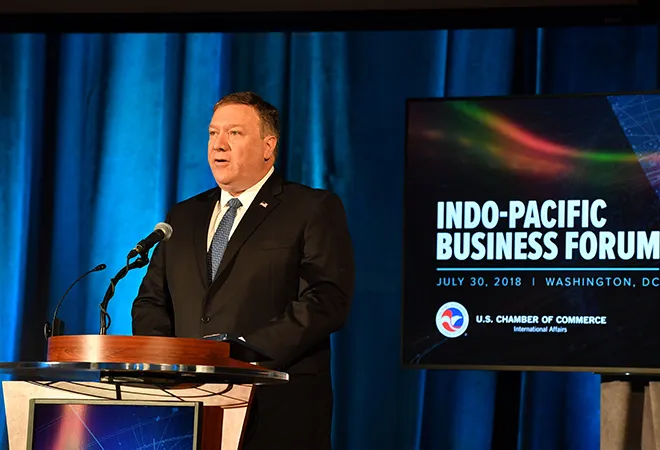-
CENTRES
Progammes & Centres
Location
Old trade battles, no doubt, will continue, but US businesses could also adjust their model.

Image Source: US Department of State — Flickr
At the Indo-Pacific Business Forum, Mike Pompeo played to US strengths by talking up the positives of the past.
Secretary of State Mike Pompeo laid out the Trump Administration’s economic strategy for the Indo-Pacific, promising “partnership, not domination” as the “great theme” of engagement.
The speech on Monday at the Indo-Pacific Business Forum was seen as a response to China’s sweeping Belt and Road Initiative although Pompeo did not mention China. Instead, he made broad claims about US efforts in the Indo-Pacific, promising a “new era in US economic commitment to peace and prosperity.”
Pompeo’s speech was meant to reassure friends and allies that the United States was back in the game, as it were, and would be a more reliable and honest partner compared to the country that went unnamed.
Pompeo was playing to US strengths by talking up the positives of the past — the Green Revolution, rebuilding Japan and South Korea — and invoking the realities of the present by promising to keep “people free of coercion or great power domination.”
Veiled references served well to remind the audience of China’s creeping domination — a fact of life in countries ranging from Sri Lanka to Pakistan to Nepal to Malaysia to parts of Africa and Latin America.
Pompeo’s speech was meant to reassure friends and allies that the United States was back in the game, as it were, and would be a more reliable and honest partner compared to the country that went unnamed.
To showcase the “whole-of-the-government” approach, the forum also featured Commerce Secretary Wilbur Ross, Energy Secretary Rick Perry and President of the Overseas Private Investment Corporation Ray Washburne. India’s ambassador, Navtej Sarna, also spoke on a panel.
On the same day, the US, Australia and Japan announced a trilateral partnership to mobilise investment in the Indo-Pacific region to enhance connectivity, stabilise economies in projects that will employ “local workforce” and avoid “unsustainable debt burdens.” Every word was a hidden weapon.
To show that Washington is moving fast, Ross unexpectedly announced India’s inclusion on a special list of “Tier 1” countries with “strategic trade authorisation” benefits, which will make exports of sensitive technologies easier. It was a vote of trust meant to show the trajectory of bilateral relations is moving in the right direction and counter the recent dissonance on trade issues.
The economic strategy unveiled by Pompeo adds another piece in the Trump Administration’s overall push for a “free and open Indo-Pacific” as outlined in its first National Security Strategy last December. In May this year the US Pacific Command was renamed the Indo-Pacific Command in a nod to India and to the real geographical area it oversees.
The economic strategy unveiled by Pompeo adds another piece in the Trump Administration’s overall push for a “free and open Indo-Pacific” as outlined in its first National Security Strategy last December.
But the economic commitment to the region that Pompeo announced in his much-anticipated initiative was a mere $113 million. He called it a “down payment,” implying there was more to come.
The figure is so small as to be quaint, especially when set against China’s projected $340 billion-commitment for BRI. Asian leaders will find the response underwhelming even if it comes with a US pledge to stay the course in the region.
A stronger response from the Trump Administration would have garnered double the benefit because BRI is under attack in Sri Lanka, Indonesia, Malaysia and even Pakistan. The onerous debt burdens have led to public questioning and a general discontent about Chinese methods. BRI projects have been suspended in Malaysia and a probe ordered.
But after 18 months of discussions and debate, the Trump Administration managed only a bare-bones response and laid most of the burden for changing the game on the shoulders of US businesses.
It wants the private sector to step up engagement in the Indo-Pacific and offer alternatives to the Chinese model. Whether US corporates will respond is far from clear.
US businesses have shown little interest in large parts of Asia because of low returns and a challenging investment climate. Increased development financing from various US government agencies may create more incentives and the US Congress is currently considering a bill to double development money.
Tom Donohue, president of the US Chamber, admitted that American companies have been “steadily losing market share in the region for years.” He blamed protectionist policies, non-tariff barriers and a web of regulations in various and he named India more than once.
The old trade battles, no doubt, will continue but US businesses could also adjust their model — they certainly did to operate in China — to find success in other countries now that their China dream has darkened somewhat. Or they can continue watching from the sidelines.
One can look at the different pieces of the Trump Administration’s Indo-Pacific strategy slowly coming together as a glass half-full. Most Asian countries want the United States as a balancer in the region — the Malaysian deputy minister for maritime sovereignty, Purbaya Yudhi Sadewa, said so publicly after Pompeo’s speech.
US businesses have shown little interest in large parts of Asia because of low returns and a challenging investment climate.
He called China the “most aggressive investor” in Malaysia. China offers deals quickly, sends teams within two weeks of initial talks and is ready to sign an MOU in two months in Sadewa’s telling. The Malaysians are reassessing Chinese offers for developing northern ports because they realised if someday things went wrong, the Chinese would own them.
Sadewa’s plea for a more substantive and sustained US response was as stark as it gets. While Washington can’t match Beijing dollar for dollar, it needs to put more teeth in the concept of a “free and open Indo-Pacific.”
Currently, the response neither reassures allies nor deters China. The idea of a Quadrilateral group of democracies (India, the US, Japan and Australia) standing together as a fence around China remains an idea for the most part with India pulling in a different direction.
Add to it the mixed messages from the Trump Administration. President Donald Trump betrays no tendency for sustained, long-term interest in any project save reducing the US trade deficit. His project to Make America Great Again includes punishing friends and allies.
His rejection of the Trans-Pacific Partnership (TPP) — the trade deal crafted by the Obama Administration to counter China — is a grim reminder of his unreliability to many Asian leaders.
But they forget that even Hillary Clinton opposed the TPP while she campaigned to be president. She wasn’t about to endorse it if she won. Interestingly, Trump has hinted he might look at the TPP again which has proceeded without the US. Mexico and Japan have already ratified the TPP and Canada may soon do the same.
Perhaps, the most important takeaway from Monday’s Indo-Pacific Forum was the cementing of criticism in Washington against China’s BRI. The age of being mindful of Chinese “sensitivities” to the extent it made any questioning or criticism of Beijing impossible, is truly over.
Perhaps, the most important takeaway from Monday’s Indo-Pacific Forum was the cementing of criticism in Washington against China’s BRI.
India can take some credit for being the first major country to clearly oppose BRI. All the reasons New Delhi cited — opacity, meddling in disputed territory, lacking environmental standards and financial responsibility and sidelining local populations — are now accepted wisdom on China’s biggest geostrategic gamble.
Washington’s contribution to the new lexicon is “predatory economics” — China’s method of luring developing countries with promises of quick loans that hide high interest rates while trapping them in a cycle of debt. Pompeo’s senior policy advisor, Brian Hook, dubbed BRI as a “made-in-China, made-for-China initiative.”
Pompeo promised the exact opposite: an inclusive model based on “high standards, transparency and adherence to the rule of law. What you see is what you get: honest contracts, honest terms and no need for off-the-books mischief.”
He also promised to “oppose any country” that seeks domination in the Indo-Pacific. But he needs more in his arsenal.
The views expressed above belong to the author(s). ORF research and analyses now available on Telegram! Click here to access our curated content — blogs, longforms and interviews.

Seema Sirohi is a columnist based in Washington DC. She writes on US foreign policy in relation to South Asia. Seema has worked with several ...
Read More +